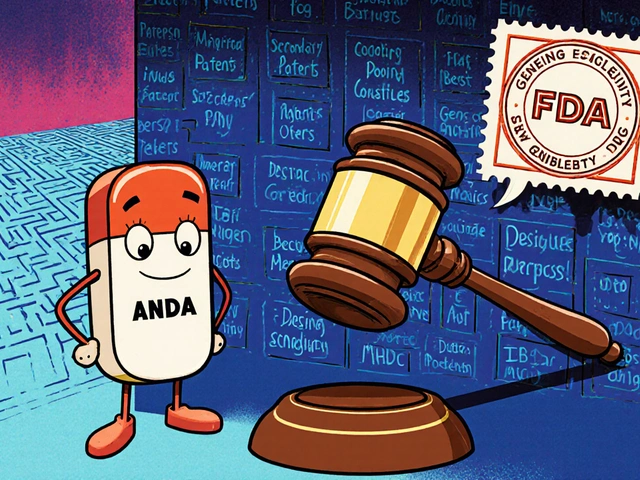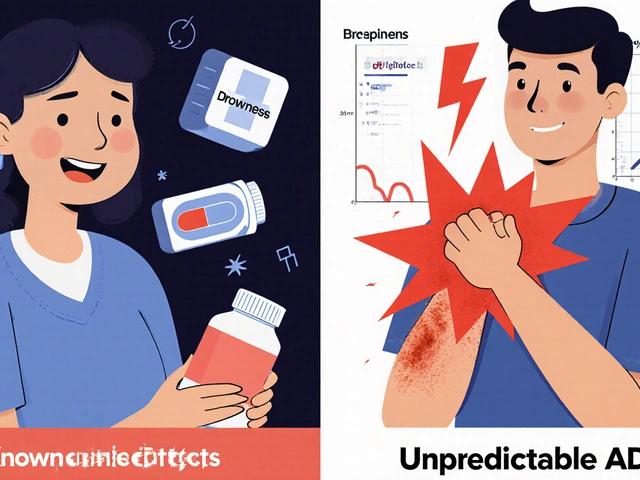Antibiotics aren’t harmless, and fluoroquinolones sit in the high-consequence bucket. If you searched this name, you probably want the straight answer: what it’s for, how to use it safely, and when to avoid it. You’ll get that here-practical, evidence-backed, and no scare tactics. Expect clear guidance on risks (like tendon rupture and nerve damage), dosing basics, interactions that block absorption, and smarter alternatives for common infections.
TL;DR: What Levoquin Is, What It Treats, Big Warnings
Levoquin is a brand name for levofloxacin, a fluoroquinolone antibiotic. It treats certain bacterial infections-pneumonia, complicated urinary tract infections, kidney infections (pyelonephritis), some stubborn sinus infections, and prostate infections. It’s powerful with excellent oral absorption, but it carries serious, well-documented risks.
- Major warnings: tendon rupture, persistent nerve damage (peripheral neuropathy), serious mental health/CNS effects, worsening myasthenia gravis, blood sugar swings, and rare aortic aneurysm/dissection risks. These are flagged by FDA and other regulators.
- Not first choice for mild infections: Guidelines advise using safer options for uncomplicated UTI, bronchitis, and sinusitis unless other antibiotics won’t work.
- Who should be extra cautious: adults over 60, anyone on steroids, people with transplant history, those with heart rhythm issues (QT prolongation), epilepsy, diabetes, a history of aneurysm, or myasthenia gravis.
- Common side effects: nausea, diarrhea, headache, trouble sleeping. Call for help immediately if you get tendon pain/swelling, severe nerve symptoms (numbness, tingling, burning), severe mood changes, chest/back/abdominal pain that feels sudden and tearing, or severe watery diarrhea.
- Key rule of thumb: if there’s a safer effective alternative, use that instead. If you and your clinician decide levofloxacin is the right pick, take it exactly as prescribed and know the red flags.
Primary sources behind these warnings include FDA Drug Safety Communications (2016, 2018), EMA PRAC recommendations (2018), and Medsafe NZ safety updates, as well as IDSA guidelines for infection-specific choices.
How to Take Levoquin Safely (Doses, Timing, Interactions)
This is a general guide. Your exact dose and duration depend on the infection, kidney function, and local resistance patterns. Never start or stop antibiotics without your prescriber.
Typical adult oral doses (examples, not a prescription):
- Pneumonia: 500-750 mg once daily for 5-14 days (severity and organism matter).
- Complicated UTI/pyelonephritis: 500 mg once daily for 7-14 days.
- Prostatitis: 500 mg once daily for 28 days.
- Sinusitis (only when other options won’t work): 500 mg once daily for 10-14 days or 750 mg daily for 5 days.
Kidney dosing: if your creatinine clearance is under 50 mL/min, the total dose usually stays the same but the interval is extended (for example, 500 mg then 250-500 mg every 48 hours). Your clinician will set this.
How to take it so it actually absorbs:
- One dose a day: Take at the same time daily. Food is okay, but heavy dairy meals or supplements can block absorption.
- Separate from minerals: Keep at least a 2-hour gap before or after iron, zinc, calcium, magnesium, aluminum (including antacids), sucralfate, or multivitamins with minerals. That includes protein shakes with added minerals.
- Hydrate: Drink water with the tablet. This helps your kidneys and may reduce crystal risk.
- Avoid sunburn: This drug can make you photosensitive. Use SPF 30+, cover up, and skip tanning beds.
- Don’t double up: If you miss a dose and it’s close to your next one, skip and move on. No stacking.
Interactions worth flagging:
- Heart rhythm drugs or risk: Antiarrhythmics (e.g., amiodarone, sotalol), some antipsychotics, macrolide antibiotics-combined QT prolongation can raise torsades risk.
- Warfarin: INR can go up. If you’re on warfarin, you may need extra INR checks.
- Diabetes meds: Risk of low or high blood sugar with sulfonylureas or insulin. Watch your glucose closely and report swings.
- NSAIDs and seizure threshold: High-dose NSAIDs may increase seizure risk when combined with fluoroquinolones if you’re prone.
- Steroids: Additive tendon rupture risk, especially if over 60.
Alcohol? Light drinking isn’t a known direct interaction, but it can mask early warning symptoms (e.g., dizziness, low sugar). Best to hold off until you’re done.

Side Effects and Red Flags: What to Watch and What to Do
Most people feel fine or mildly off. The concern with levofloxacin isn’t that common side effects are unbearable, but that rare ones can be serious and sometimes permanent. That’s why regulators advise using it only when needed.
Common effects (often mild, day 1-3):
- Nausea, stomach upset, diarrhea
- Headache, dizziness
- Insomnia or strange dreams
- Mild sun sensitivity
What helps: take with a light meal (avoiding mineral-heavy foods within the 2-hour window), hydrate, and go easy on caffeine if you feel jittery.
Serious effects-stop the drug and contact a clinician urgently (call emergency services if severe):
- Tendon pain, swelling, or sudden pop-especially Achilles. Can happen within hours to months after use. Rest immediately.
- Nerve symptoms: numbness, tingling, burning, weakness-especially in hands/feet. These can persist.
- Mood or CNS changes: agitation, anxiety, confusion, hallucinations, seizures.
- Severe blood sugar swings: shakiness, sweating, confusion (low); or increased thirst, frequent urination (high).
- Chest, back, or abdominal pain that is severe, sudden, and tearing-seek emergency evaluation for possible aortic event, especially if you have risk factors.
- Severe watery diarrhea (possibly bloody), abdominal cramping, fever-can signal Clostridioides difficile infection. This can start during or weeks after antibiotics.
- Worsening muscle weakness if you have myasthenia gravis.
Who is at higher risk:
- Age 60+, current steroid use, or organ transplant (tendon rupture risk)
- History of aneurysm or conditions that weaken blood vessels (e.g., certain genetic disorders), uncontrolled hypertension, or heavy smoking (aortic events)
- Diabetes (blood sugar swings)
- Seizure disorders, or taking medicines that lower seizure threshold
- Known QT prolongation or low potassium/magnesium
Simple safety checklist to use before and during treatment:
- Confirm the bug and the need: Ask if a culture was done and why this drug was chosen over safer options.
- Share your meds: Bring a list of prescriptions, supplements, and over-the-counter antacids or vitamins.
- Plan dosing around minerals: Set reminders so tablets aren’t taken with iron or calcium.
- Watch for red flags daily: Tendon pain, new numbness, mood shifts, severe diarrhea, or chest/back pain.
- Know your exit: If a serious effect starts, stop the medicine and call for advice immediately.
Pregnancy and breastfeeding: Fluoroquinolones are usually avoided in pregnancy due to animal data on cartilage, and they’re not first choice during breastfeeding. If you’re pregnant or nursing, discuss alternatives with your clinician.
When to Use It vs Skip It: Scenarios, Alternatives, and a Quick Table
Big picture: use the right tool for the job. For many common infections, safer first-line antibiotics work just as well with fewer serious risks. Fluoroquinolones like levofloxacin are typically reserved for resistant infections, allergies to first-line drugs, or specific pathogens.
Scenarios most people ask about:
- Uncomplicated UTI in otherwise healthy adults: Try nitrofurantoin or trimethoprim-sulfamethoxazole (if local resistance is low and no allergy). Levofloxacin is not first-line.
- Acute sinusitis: Many cases are viral. If bacterial and moderate, amoxicillin-clavulanate is usual first-line. Levofloxacin is a fallback if severe allergy or failure.
- Community-acquired pneumonia: Depending on severity and comorbidities, options include amoxicillin, doxycycline, or a macrolide; fluoroquinolone monotherapy can be used for higher-risk adults when indicated.
- Prostatitis: Levofloxacin is often used due to tissue penetration, but risks still apply-ensure the expected bug is susceptible.
- Complicated UTI/pyelonephritis: Reasonable option if susceptibility confirmed or likely and alternatives aren’t suitable.
Decision heuristics:
- If your infection is mild and there’s a safer effective antibiotic, pick the safer one.
- If you’re over 60, on steroids, or have aneurysm risk, avoid fluoroquinolones unless clearly necessary.
- Always separate doses from minerals by at least 2 hours to avoid underdosing from poor absorption.
- Stop immediately at the first sign of tendon or nerve issues-waiting increases the chance of long-term harm.
| Indication | Typical Adult Dose | Usual Duration | First-line? | Common Alternatives |
|---|---|---|---|---|
| Community-acquired pneumonia | 500-750 mg once daily | 5-14 days | Sometimes, for higher-risk adults | Amoxicillin, doxycycline, macrolide (check local resistance) |
| Complicated UTI / Pyelonephritis | 500 mg once daily | 7-14 days | Often appropriate when indicated | Trimethoprim-sulfamethoxazole, beta-lactams (if susceptible) |
| Prostatitis (bacterial) | 500 mg once daily | ~28 days | Common choice with susceptibility | Trimethoprim-sulfamethoxazole |
| Acute bacterial sinusitis | 500 mg once daily or 750 mg once daily | 10-14 days or 5 days (750 mg) | No, reserve for failures/allergy | Amoxicillin-clavulanate, doxycycline |
| Uncomplicated UTI | Not preferred | - | No | Nitrofurantoin, trimethoprim-sulfamethoxazole |
Note: Dosing must be adjusted for kidney function below ~50 mL/min; your prescriber will tailor frequency.
Why guidelines are conservative: The FDA (US), EMA (EU), and Medsafe (NZ) warn that for sinusitis, bronchitis, and uncomplicated UTI, the risk of serious side effects can outweigh benefits when other options exist. IDSA adult guidelines echo this, steering first toward safer, targeted antibiotics.

FAQ and Next Steps
Short answers to the questions people ask after they pick up a prescription.
Is Levoquin the same as Levaquin? Yes-different brand names for levofloxacin. Many places dispense generic “levofloxacin.”
How fast will I feel better? Many respiratory symptoms improve within 48-72 hours if the bug is susceptible. UTIs often settle within 24-48 hours. Finish the course unless your prescriber tells you to stop due to side effects.
Can I take it with dairy? Light dairy in food is usually fine, but calcium-rich meals or supplements can bind the drug. Keep a 2-hour buffer before and after mineral-containing products.
Can I drive? If you feel dizzy, jittery, or have vision changes, don’t drive. Try your first dose when you can be at home for a few hours.
What about sun exposure? Use SPF 30+, cover up, and avoid midday UV. This drug can amplify sunburns.
What if I get tendon pain? Stop the medicine immediately, rest the limb, and contact your prescriber. Early action reduces the chance of rupture.
Can I take it if I’m pregnant or breastfeeding? Usually avoided. Ask your clinician about safer alternatives, like certain beta-lactams, depending on the infection.
Will it mess with my gut? Like all broad-spectrum antibiotics, it can. Eat simple, non-greasy foods. If you get severe watery diarrhea during treatment or within two months after, call a clinician to rule out C. difficile.
Does it help with COVID or flu? No. It’s for bacteria, not viruses. It can be used if there’s a confirmed bacterial pneumonia overlap, but that’s a medical call.
What if my culture says the bacteria is resistant? Your prescriber will switch you. Don’t finish a drug that lab testing shows won’t work.
Is it used in kids? Usually avoided due to cartilage/tendon concerns unless benefits clearly outweigh risks.
Next steps if you’re deciding whether to take it:
- Confirm the diagnosis: Was this a clinical call or is there a positive culture?
- Ask for alternatives: “Is there a safer antibiotic that would work for my case?”
- Audit your meds: Share any heart meds, diabetes drugs, steroids, antacids, or supplements.
- Make a dosing plan: Pick a daily time and set reminders, keeping the mineral gap in mind.
- Plan check-ins: If you’re on warfarin or have diabetes, arrange INR or glucose follow-up.
If you’ve already started and something feels off:
- Mild nausea/insomnia: Try taking with a small meal earlier in the day; avoid late caffeine.
- Missed dose: Take it when remembered unless close to the next dose.
- Side-effect red flags: Stop the drug and call a clinician. If severe chest/back/abdominal pain or new weakness in a limb, seek emergency care.
- No improvement in 72 hours: You may need culture results reviewed or a switch based on susceptibility.
Local context (New Zealand): Levofloxacin is prescription-only. Medsafe has aligned warnings with FDA/EMA, emphasizing cautious use and reserving fluoroquinolones for cases where benefits clearly outweigh risks. Availability, brand names, and funding can vary; your GP or pharmacist can advise what’s stocked and appropriate in your region.
Why clinicians still use it despite the risks: It reaches high blood levels, penetrates tissues well (like lung and prostate), and covers a broad range of bacteria, including some resistant strains. Those advantages matter in complicated infections-just not for every cough or UTI.
Credible guidance used here: FDA Drug Safety Communications (2016 update on disabling side effects; 2018 mental health/hypoglycemia updates; aneurysm risk notes), EMA PRAC recommendations (2018 restrictions), Medsafe NZ safety communications, IDSA guidelines on community-acquired pneumonia, urinary tract infections, and prostatitis, and WHO AWaRe classification highlighting stewardship.
One last practical tip: If your infection is stable and you’re unsure about taking a fluoroquinolone, it’s reasonable to ask for a 24-hour pause to discuss alternatives-unless your clinician says delay would be risky. Infections vary, but your safety questions are valid and welcome.






Gregg Deboben
September 13, 2025 AT 04:35This is why America's healthcare is a joke. They give out antibiotics like candy, then act shocked when people end up with ruptured tendons and brain fog. 🤬 I had Levoquin prescribed for a sinus infection that was probably viral. Now I got chronic nerve pain and my doctor shrugged. No accountability. Fuck this shit. 🚫💊
Christopher John Schell
September 13, 2025 AT 07:40Hey, I get it - scary stuff, right? 😅 But don’t throw the baby out with the bathwater. I was on this for a bad UTI after 3 other antibiotics failed. It saved my butt. 🙌 Just listen to the warnings: no calcium supplements right after, drink water, watch your tendons. You got this! 💪 Stay smart, not scared. #AntibioticAwareness
Felix Alarcón
September 14, 2025 AT 10:08Man, I appreciate this post so much. I'm from Mexico originally, and back home, people just walk into pharmacies and grab cipro like it's aspirin. 🌎 It's wild how different the approach is. Here in the US, we're finally catching up to the fact that these drugs aren't 'just pills' - they're surgical tools. Thanks for laying it out so clearly. I'll be sharing this with my family. 🙏 Also, typo: 'sucralfate' was spelled right - props to the writer!
Lori Rivera
September 16, 2025 AT 04:02While the information presented is comprehensive and aligns with current clinical guidelines, the tone of the article occasionally veers into alarmist territory, which may undermine its credibility among patients who require balanced, evidence-based guidance. The inclusion of regulatory references is commendable, though a more neutral presentation would enhance its utility in clinical decision-making contexts.
Leif Totusek
September 16, 2025 AT 15:55Thank you for the meticulous and clinically grounded summary. As a healthcare professional, I appreciate the adherence to IDSA, FDA, and EMA guidance. The structured presentation of dosing, contraindications, and alternatives is exemplary. I will be incorporating this as a patient handout in my practice. The emphasis on mineral separation and tendon vigilance is particularly critical and often underemphasized in primary care settings.
KAVYA VIJAYAN
September 17, 2025 AT 04:32Look, fluoroquinolones are a double-edged sword - their pharmacokinetics are *beautiful*: high bioavailability, tissue penetration into prostate, lung, even CSF in inflamed states, and broad-spectrum coverage including Gram-negatives like Pseudomonas and resistant Enterobacteriaceae. But the mitochondrial toxicity? That's the kicker. They inhibit topoisomerase II in human mitochondria, leading to oxidative stress, ATP depletion, and that's why neuropathy and tendonopathy are delayed and sometimes irreversible. The FDA black box isn't hype - it's structural biology. And yeah, for uncomplicated cystitis? Nitrofurantoin's efficacy is 92% with zero mitochondrial sabotage. Why risk a 0.2% chance of permanent nerve damage when you can use a drug that's been around since 1953? Also, the aortic dissection link? Mechanism isn't fully mapped, but MMP-2/9 dysregulation via TGF-beta signaling is suspected. If you've got hypertension or Marfan, avoid like the plague. This isn't just 'side effects' - it's epigenetic sabotage.
Jarid Drake
September 18, 2025 AT 22:16Just finished my 14-day course of Levoquin for a nasty pneumonia. Felt weird the first day - kinda dizzy - but followed the 2-hour mineral rule and drank a gallon of water. No issues. Honestly, this post saved me from panic. Thanks for the checklist. 🙏